Welcome to the internet portal "Cosmopolis". On this website you can read creative articles that are not available anywhere else, which differ considerably from the existing, omnipresent "black and white views" of the world. The author of the Dialectical Interactive Approach doesn't expect you to agree with the ideas and thoughts presented, but if you want to read something different from existing, ideologically deeply imprinted thought patterns, then do not miss this opportunity. Especially, because this creator of knowledge developed and presented a completely new methodological approach (dialectical interactive approach) based on a new conception of time and space, which, despite the differences, complements and supplements Newton's and Einstein's understanding of space and time. Through the prism of this reintroduced methodological approach, many hot topics are reconsidered and reexamined, such as contemporary natiocratic social orders, including the corresponding political and economic systems, the role of religion and financial markets in them, freedom (of speech, freedom of creative action, .. .. freedom of will, freedom of choice), democracy, a re-examination of paradoxes, phenomena, and optical illusions that take place in the depths of the cosmos, and the like.
Note that the dialectical interactive approach with its methodologically powerful creative framework is currently the most advanced methodological approach. If to this is added that this revived dialectical understanding of time and space, unlike other conceptions of space and time that are suitable only for use in the scientific fields of the physical universe, is also applicable in many areas of the social universe, a more complete picture of the creative activity of this creator of knowledge is got. In short, if the ancient and medieval conceptions of space and time are excluded, where the Earth was conceived as the center of the Universe, after Newton's and Einstein's understanding of space and time, this is the third conception of time and space that was devised in the post-Copernican age of the heliocentric Universe. For this reason, keep reading this creative article to the end, and then make your judgment about the aforementioned.
dialectical understanding of time and space
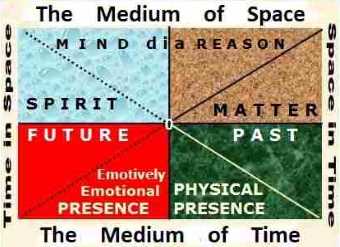
Dialectical Conception of Time and Space, the result of which is the Abstract Methodological Creative Framework of the Dialectical Interactive Approach. Space in Time includes external (physical) expanses that can be properly perceived with the five basic senses, and then processed in this Dialectical Medium of Time and Space, while Time in Space includes everything else that can only be sensed or felt with the remaining two human senses, such as the dialectical worlds within me ⇄ thee ⇄ us, including creative worlds of ideas, optical illusions and ghostly events in the unfathomably distant past of the universe, which in the earthly sense are equivalent to images of mirages in the desert and the like.
The dialectical understanding of time and space is based on lost, hidden knowledge, whose methodological pillars are the ancient four elements: fire, water, air, and earth. This revived dialectical understanding of space and time plays a central role in the dialectical interactively creative approach. As will be shown later, the four concrete key concepts of the dialectical understanding of time and space [Time in Space ⇄ Space in Time DIA Medium of Time ⇄ Medium of Space] are paired and harmonized with these four abstract dialects (fire, earth, air, water). The result of this pairing of abstract (figurative) and concrete dialects is the Abstract Methodological Creative Framework of the Dialectical Interactive Approach for pictorial representation and formulation of the perceived creative challenge of time, within this dialectical understanding of time and space. In this methodological approach, space and time are fundamental and universal building blocks; two mutually understandable and compatible mega-dialects that permeate one another as well as create an appropriate framework for various ways of creatively interactive manifestation of the matter and spirit, understood also in terms of thy physical and emotively emotional presence, without which the processes and phenomena in the physical (outer) and spiritual (inner) worlds cannot be understood, elaborated, explained nor imagined.
To mitigate the harmful influence of widespread materialistic understanding and corresponding views of the world that surrounds us, and in which I ⇄ thou ⇄ we also live, earn and create, the dialect-spirit was reintroduced to this creative scene. Despite the good intentions of this creator of knowledge, this was met with strong resistance from the very beginning by the mechanical structures, which still hold tightly all the strings of these modernized natiocratic social systems. In a broader methodological context, the dialect-spirit was used in a metaphysical and figurative sense to refer to the unknown, enigmatic, invisible (external and) internal (non-physical) spaces of the mega dialect - space, understood in terms of Time in Space [NOW and THERE], that is, future hidden in the dialect - spirit (spiritual spaces), which can potentially be manifested in external worlds of the matter, already embedded in the past (Space in Time). In other words, seen from a dialectical point of view, these hidden dialectical contents are still unknown, invisible, and inconceivable to the five basic senses, which are only suitable for orientation in the near external worlds of matter already embedded in the past [Space in Time: HERE and NOW].
- The inadequate use of these five basic senses (used by animals too), whose purpose is orientation on very short distances of space and time, is the main cause of various deviations and phenomena of the Time in Space (the future hidden in the spirit) DIA Space in Time (matter already embedded in the past). In other words, the five basic senses are only a means to help living beings deal with the world around them. On the other hand, very complex dialectical contents should be (properly) reconsidered, interpreted, and reflected in the time DIA space through the prism of two TYPICAL human senses [the sense of intuition and the sense of inner feeling of self] within the appropriate medium of space (mind dia reason) by using human common sense: the SPIRITUAL presence, understood in the sense of emotively emotional presence (NOW and THERE).
- In other words, the physical presence (of a body) is a passive observer of the reflection of a manifestation of matter (star, galaxy...) embedded in the (remote) past [distant events of the SPACE IN TIME], including ghostly and spooky, still glowing matter, already gone in the past, which has been wrongly perceived as "HERE and NOW". Another example of looking backward in time (and space), we see the Sun [Space in Time: matter embedded in the past] with the sense of sight after processing this sensory perception in the Dialectic Medium of Time and Space, as it appeared (the HERE and NOW on the Earth) for eight minutes ago, and not exactly as it looks NOW and THERE [the real Sun: the invisible Time in Space] at that moment. Taking into consideration that this methodological approach, as well as this dialectical understanding of time and space, is based on an individual way of thinking, to understand and then properly reason about such types of deviations, that is, to understand the various paradoxes manifested, phenomena, self-deceptions, and (optical) illusions of the (recti)linear understanding of space [ matter, fused mind-spirit ] and time (the past ⇢ present ⇢ future), instead of the dialect - present, the dialect physical DIA emotively emotional PRESENCE was used for the various kinds of traveling through this dialectical comprehension of time and space, including also the creative journeys.
- In summary, these phenomena and optical illusions of the rectilinear understanding of distant time and space are actually a result of the ABSENCE of physical presence (dialect - matter: thy body, for example) on the place in time and space, where you want (EMOTIVE - EMOTIONALLY) to be present (dialect - spirit) at that very moment and place. In other words, all these known and unknown deviations and phenomena of the time "AND versus DIA" space, including the related optical illusions, are in fact consequences of the rendering (translation of) these complex dialectical processes, whose basic characteristic is a change of state (Dialectics) and not a movement through time and space (Dynamics), understood as a reinterpretation of these dia-processes of change in the (recti)linear sense: (over)simplification DIA (recti) linearization of these complex dialectical contents by (limited abilities of) the sense of sight that is constrained by the EXTERNAL (limit of the speed of) light. In order to clearly distinguish these different conceptions of the understanding of time "AND versus DIA" space from each other, a new adjective - conjunction "DIA" was introduced as a replacement for the (recti) linear conjunction "AND".
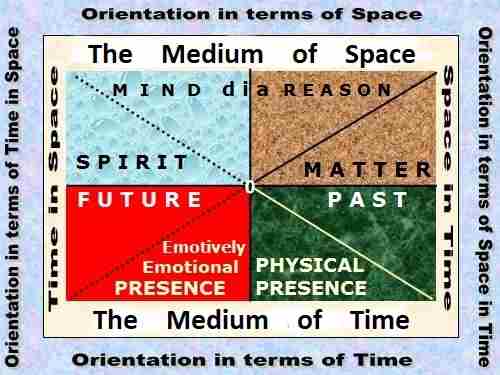
Dialectical Understanding of Time [future, emotively emotional presence dia physical presence, past] and Space [spirit, mind dia reason, matter] in Picture and 4 Key Concepts, expressed by its Two Paired Dialects: Time in Space ⇄ Space in Time DIA Medium of Time ⇄ Medium of Space
Source: Proposal for a Potential Ph.D. Dissertation at the Copenhagen Business School, Denmark, Jovanović, 1999
From the aforementioned it follows that the dialect - TIME IN SPACE (future hidden in spirit: NOW and THERE) presents the outer, (very) remote, and unknown worlds of dialectics, including the spooky, nonexistent, but still visible worlds of the unfathomably distant past of the universe, as well as the inner (hidden) dialectical worlds within me ⇄ thee ⇄ us, which I ⇄ thou ⇄ we only can sense by the two typical human senses: The sixth sense (the sense of presentiment: intuition) and the seventh sense [the emotively emotional sense of inner feeling of self], understood in terms of thy emotively emotional presence within these vast INNER expanses of (the OWN) time DIA space. On the other hand, physical aspects and the ubiquitous external manifestation of space and time is pictorially presented in this dialectical understanding of space [spirit, mind dia reason, matter] and time [future (within thee), emotively emotional dia physical presence, past (around thee)] as SPACE IN TIME (here and now), that is, the matter which is already embedded in the past. Seen from the perspective of the dialectical understanding of time and space, when the hidden and imperceptible intentions and intentionalities of the actors of Time in Space (NOW and THERE) are outwardly manifested and physically realized HERE and NOW (Space in Time: matter embedded in the past), then this dialectical process of change, and not rectilinear or linear movement in time OR space, is irreversible, because both time and space are fused, integrated and imbued with each other through the concrete manifestation of their constituent dialects.
Since all ideas, thoughts, and sense-experiences related to time and space are molded by the purposeful consciousness of key-actors in the considered range of time and space, also understood in terms of their (subjective) ways and abilities to perceive and cognize this reality including its creation and transformation, there is a need for a medium in which to present, interpret and comprehend the meaning and significance of these hidden inner intentionalities (Time in Space) in interaction with perceived external sensory experiences of Space in Time. In this revived dialectical understanding of space and time, the spatial medium is represented by the dialect - mind dia reason, while the corresponding medium of time is represented by the emotively emotional dia physical presence of the individual in the considered range of space, understood in terms of the appropriate time interval. It follows from this, unlike other conceptions of space and time, in which these ideas, thoughts, mental actions, perceptions, acquired experiences, and sensory observations are felt, experienced, further processed, and reduced to a general (common) medium of time in compliance with how the natiocratic elite understands space and time, which allows them to keep a huge mass of people under control, and in this way to more easily rule over this type of manifestation of the mob, divided and organized into akin groups,
- [the medium - present in this created universe of matter (physical universe), that is, the current sensory experience and cognition of the existing physical reality): PRESENT (time), which is the result of the process of objectification of these (subjective) sensory experiences, mental actions, and knowledge about happenings in space and time (including also forcible and imposed ways to achieve that goal)],
the dialectical comprehension of time and space is based on individual sense-experience and reasoning including a deeper insight into these phenomena and events around me ⇄ thee ⇄ us, which take place in the material (external) and spiritual (inner) worlds of the dialectics using the common sense of the human being.
- Instead of the until then dominant (and common) understanding of the flow and passage of time in terms of the arrow of time (past → present → future), in Einstein's understanding of time as the fourth dimension in his model of physical reality, the distinction between past, present, and future is only a stubbornly persistent illusion, because they all exist equally. In other words, according to Einstein, "time does not flow (it only seems so) but it just is." As a result of this applied generalization and uniformity, the relativistic understanding of time does not flow at the same rate for everyone, everywhere. The speed at which time flows depends upon where you are, as well as how fast you travel through space and time.
On the other hand, this creator of knowledge goes even further, turning upside down this classical, rectilinear understanding of the flow of time (past → present → future). As a result, in this dialectical understanding of time (and space) related to the desired future course of events, its constituent dialect - future springs from these endless, inner, invisible, and hidden expanses of Time in Space [future hidden in the dialect - spirit] to illuminate with its short-lived flash and thus leave a mark in these (changeable and transitory) material worlds of Space in Time (matter already embedded in the past), and for this reason, these external events are perceptible with the five basic senses in terms of presenting and interpreting these dialectical contents as HERE and NOW. Consequently, in this dialectical understanding of time (and space), there are countless such directed arrows [of desired or desirable developments of future events ("future")] from these hidden, inner worlds of Time in Space (NOW and THERE) to the targeted outer worlds of Space in Time [HERE and NOW: external dialectical worlds of matter already embedded in the past].
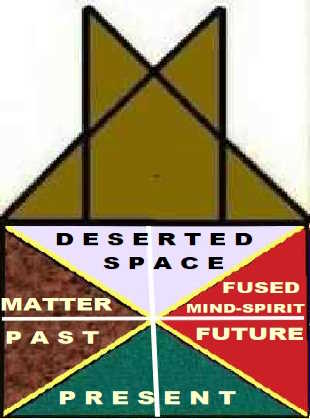
Methodological Reasoning in the sense of Understanding (Recti)linear Time and Space AS SOMETHING OUTSIDE OF US, or around us, but not inside me ⇄ thee ⇄ us
For this reason, it could be argued that the dialectical understanding of the flow of time, related to the place and role of the dialect- future in it is PROACTIVE, while the usual understanding of the flow of time in terms of the arrow of time (past → present → future) is PASSIVE (observation), or in at best, an active participation, but in these external events of Space in Time. Seen from this perspective of the dialectical understanding of time and space, the rectilinear observation of space and time in the sense of its flow from the past to the present to the future in the form of an arrow of time is generally speaking the end result of understanding not only space but also time as something outside of us in conjunction with the consideration of these two mega-dialects separately from each other, while the methodological relationship between cause and effect is completely neglected (Cause → Effect). In the external concrete, physical sense, this is expressed as an irreversible transformation and metamorphosis of the internal Time in Space (Cause) into external Space in Time (Effect), that is, as an irreversible transition with a short-lived flash of the hidden and cocooned Future in the Spirit (NOW and THERE) in some form of observable physical manifestation of Matter embedded in the Past (HERE and NOW). Or expressed in another way, this short-lived flash of the hidden and wrapped Future in Spirit (Time in Space) in some form of noticeable physical manifestation of Matter embedded in the Past (Space in Time) is actually a building and creating conditions for the future in this external environment (physical reality: the realm of the 5 basic senses).
- In the netmodal sense, this is actually about strengthening and consolidating the actor's position (Positional Netmodule), as well as further long-term structuring and networking (Structural Netmodule) in the external (business) environment using the acquired experience and created knowledge (Process Netmodule) through established relationships (Relational Netmodule).
For this reason, this myriad of dialectical manifestations of the (potential) future [embedded in spirit (Time in Space): an individual or singular way of thinking] contradicts this one-sided, but generally accepted rectilinear understanding of the arrow of time [past → present → future], which begins and puts the effects in focus while the "cause" is a kind of assumption, a generalization of expected trajectory of future events, or (extrapolative) inference about the future course of events within this external understanding of time (and space), which rests on known facts, perceptions, and observations from the past (timeline). In short, apart from being methodologically inconsistent, this one-sided seeing, seeking, and beginning of (this potential) future in these outer expanses of domination and rule (of matter already embedded in) the past is illusory and self-deceiving, especially, if all of this aforementioned is observed and considered from an individual point of view. In other words, no one can see mathematically precisely with the sense of sight (HERE and) NOW, that is, the present, measured by the speed of light, because there is always a physical distance between the one who looks and what is being looked at but only with this tiny delay can one perceive the glorious flash of the elusive, unstoppable, and untamable future (enveloped in spirit) in these outer worlds of Space in Time, ruler of which remains (matter embedded in) the Past. Regardless of this, to survive in these external, dialectical worlds of Space in Time, it is necessary not only to adapt to the daily situation in this changing environment but also from time to time, creatively active and proactive flashing with the dialect - future from its hidden inner source (Time in Space: NOW and THERE).
In short, all this resembles a slowed down, faster, or (significantly) accelerated beating of the "heart" for the purpose of maintaining (thy) physical presence in the sense of HERE and NOW (Space in Time), as well as to renew and refresh these physical expanses of matter already embedded in the past. Or as it was previously emphasized, these continual short-term flashes of the hidden inner Time in Space into some form of observable or perceptable outer Space in Time not only create the preconditions but also provide a clear motive for the further functioning of this inner Future (enveloped in Spirit) by giving in that way both the full meaning and ultimate purpose for her further action within these endless worlds of dialectics. Or to put it another way, the future and its springs should be sought within these inner expanses of TIME IN SPACE [the hidden future in the spirit: NOW and THERE], and thus time begins there, while all these (hidden) intentions and intentionalities are realized or not, in the outer worlds of Space in Time (HERE and NOW).
I hope it is now easier to understand why in the dialectical understanding of time, the future is listed as the initial dialect and not the past, and why the constituent dialects of time are not arranged in a straight line but are simply separated from each other using a comma, although it could be depicted pictorially in a linear sense as the future └── emotively emotional presence dia physical presence (Medium of Time) ──┘ the past, where future and past are pictorially presented as something behind corners of this dialectical pyramid of mega-time and mega-space. For additional information about this dialectical way of understanding the dialect - future, read the creative article: The Arrow of Time VERSUS The Multitude of Arrows of Time. In summary, presented dialectical understanding of time and space in full compliance with this methodological approach (dialectical interactive approach), in fact, complements and supplements Newton's (Static: Absolute) and Einstein's (Dynamic: Relativistic) understanding of space and time. For additional information, read: Dialectical Conception of Time DIA Space.
Dialectical Creatively Interactive Approach
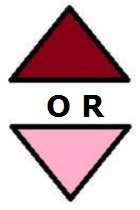
Bipolar DIA Binary Way of Thinking
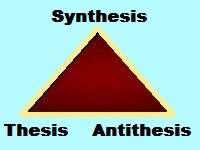
The Ultimate Synthesis as the Ultimate Outcome of the Classical Dialectical Way of Thinking, a Kind of Current (Earthly Understood) Dogma, an Ultimate Outcome of the Binary "EITHER - OR" Choice between TWO Bipolar Dialects - Abandoned Hollow and Present within this Triangular Understanding of Space and Time
Although Jochan Gotlieb Fichte introduced into German philosophy the three-step of the thesis, antithesis, and synthesis, this classical dialectical method is not in full compliance with the dialectical creatively interactive approach. In short, an initiated debate using this classical dialectical approach is ended by an ultimate synthesis, which is pictorially represented by a triangle, and not by a pair of matching and paired triangles. In other words, this dialectical approach is still within the methodological limits of the fundamental postulates of the mob DIA group's way of thinking, whose main feature is the appliance of various manifestations of (physical) power and might, as the final result of the still ruling thinking in terms of "either Black or White" (bipolar dia binary way of thinking). An example of this implemented approach in the living reality is the tragic fate of Socrates [hence the name 'devil's triangle']. It follows from all the above that this classical dialectical approach would still be very suitable for contemporary natiocratic political systems because its ultimate synthesis as a kind of dogma would be very difficult to challenge and especially to change, in spite of the fact that change is a basic and innate property and feature of the dialectic. As it will be demonstrated, the point of the dialectical interactive approach is not in the struggle of (multitude of) thesis and antithesis but in the mutual CREATIVE complementarity and supplementarity of each other (the couple dialects) during the initiated dia-processes.
In addition to this prerequisite, the dialectical interactive approach due to its "Background Simulative Methodological Assumptions" also requires that each dialectical content under creative consideration is (again and again) reconsidered from (tri)angles of the great pyramid of culture, philosophy, art, and science, understood in terms of the application of appropriate "Ultimate DIA Probable Methodological Presumptions" of this revived methodological approach", which is based on Human Common Sense. In other words, the human common sense functions following basic principles of the dialectical interactive approach because this individually creative, human, and human-loving methodological approach allows participation DIA FACTUAL CREATIVE PRESENCE, not only of the existing (still living) actors ( physical presence ) but also of the actors DIA THEIR GREAT (SPIRITUAL) IDEAS AND THOUGHTS of the gone past ( emotively emotional presence ), as well as of actors, who will one day cross the threshold of this great creative stage (desired emotively emotional presence dia physical presence). A great creative stage, intended and created for the purpose of creating (pre)conditions for a FAR MORE HUMAN AND HUMAN-LOVING clash of ideas, thoughts ... within this reintroduced spatial MEDIUM ( mind dia reason ) DIA corresponding medium of time, a temporal medium of thy emotively emotional dia physical presence, using available linguistic dialects of this revived methodological approach.

Couple Dialect (Matching and Paired Dialects): Thesis DIA Antithesis, symbolically represented by using linguistic Dialects: the Same (water) and the Different (air)
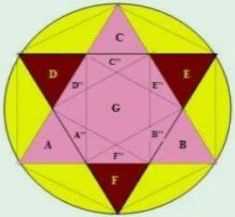
Synthesis (Six-Pointed Star) DIA "G" - Hexagon → The Renewed Thesis in Time DIA Space
The developed methods of dialectical interactive approach with their methodical procedures and techniques offer a very powerful tool for discovering the unknown in time DIA appropriate space, understood in terms of the methodological monitoring, consideration, and re-examination of initiated creatively interactive processes of knowledge creation. All these dialectical methods are based on the built-in manifestation of related "quartets" [three (3) DIA one dialect (1)] in the methodological creative framework of the dialectical interactive approach which greatly facilitates the application of these dialectical methods in solving various creative challenges of the time, in time DIA space. The presented dialectical quartet of the thesis, antithesis, synthesis (triad) DIA the renewed thesis (their unity and oneness), which is supplemented and complemented by an amended antithesis and so on, until the temporary conclusion of the time DIA space is achieved, was inspired by and evolved after unraveling dialectos of Plato: Timaeus.
In this pictorial parable of Plato (dialectos), a charming presentation of the THESIS and ANTITHESIS was depicted with two triangles, which were symbolically represented as a pair-dialect by using linguistic dialects: the Same (water) and the Different (air). Plato's interpretation of synthesis is presented by the six-pointed star, while its hexagon ("G") represents the renewed thesis. As a pictorial representation of the continuation of this initiated debate in time DIA space, a new six-pointed star (dialectical synthesis) was used consisting of two matching, paired, and dialectically merged triangles of thesis and antithesis, depicted within this aforementioned hexagon. In other words, the renewed thesis is contradicted, respectively complemented and supplemented by an amended antithesis, the dialectical content of which is again dialectically synthesized as a whole which is made and represented by this new six-pointed star (synthesis) DIA its hexagon (G'), which represents the supplemented and renewed thesis at a new (preferably to a qualitatively higher) level of time DIA the appropriate space and so on, creatively traveling through this dialectical understanding of time and space until the temporary conclusion of the subject under creative consideration was achieved: The last renewed thesis (of the winner of this initiated creative debate). Or to put it another way, the conclusion reached in this creative discussion is temporary and for now undisputed. To summarize the aforementioned, it is unquestionable, not in the sense of (unfounded) criticism, but in the sense of the ability of other pretenders to create a stronger dialectical content, and then to elaborate it in detail, clearly explain it, and finally successfully defend it, by applying this methodological approach ( dialectical interactive approach ), in order to sit on this throne of manifested creativity.
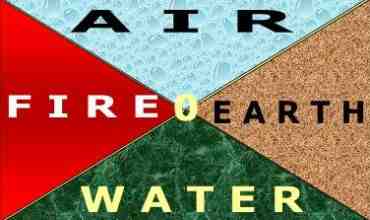
SECRETS OF THE FOUR ELEMENTS: The Unity and Struggle of Dialectical Contradictions in Time DIA Space
DIA
The Four Primary DIA Proto Paradigmatic Presumptions of the Dialectical Interactive Approach
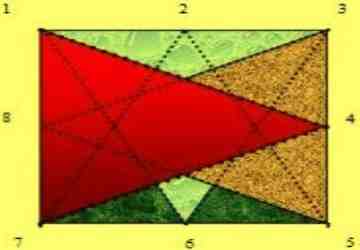
Germinating DIA Potentially Fruit- Bearing Eight-Pointed Star
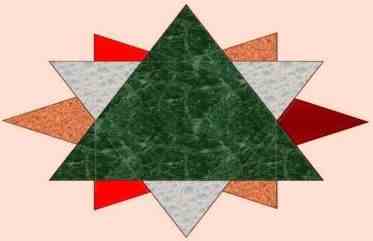
A Blossomed, Potentially Ripe Fruit - Bearing Twelve - Pointed Star
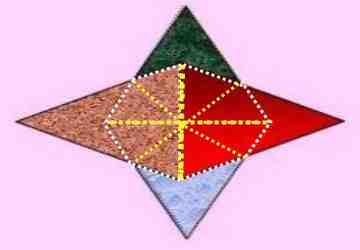
Fruitful DIA Potentially Germinating Four-Pointed Star
and so on in Time DIA Space, until was reached stage of the development of
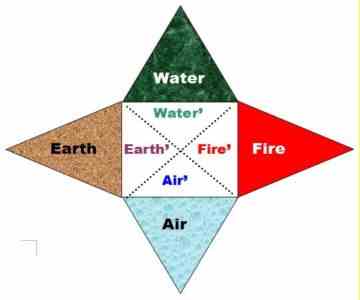
A FOUR-TRIANGULAR STAR of the Four Elements: Fire, Earth, Air, Water
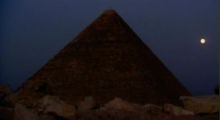
This Ground Plan, based on the Four Abstract Elements of this Four-Triangular Star in conjunction with this dialectical understanding of Time and Space, the final result of which is this Methodological Approach (Dialectical Creatively Interactive Approach), was eternalized with the Construction of the Cheops Pyramid in Egypt
In full compliance with the presented dialectical interactive approach, this achieved temporary conclusion will be challenged sooner or later. In other words, its synthesis DIA the renewed thesis will be faced by a renewed and supplemented antithesis of the ripe time DIA space for the continuation of this endless creative confrontation of ideas and thoughts within this dialectically commonsense understanding of space and time. Note, for this graphical presentation of a debate was used the ANCIENT perceiving and awareness that within each hexagon can be drawn a six-pointed star and vice-versa. This essential feature (of the dialectic) is valid and applicable FOR EACH KIND OF STAR, which allows dialectical processes of different levels of complexity to be displayed and unfold within these star-shaped creative interactive frameworks, as well as to provide the possibility of creative combining and mutual dialectical synthesizing and summarizing of these picturesquely symbolic, interactively creative contents. In summary, the main feature of this methodological approach is the use of the linguistic pictographic language of symbols ("ideograms"), as a sort of a pictorial writing system intended for an advanced way of CREATIVELY INTERACTIVE communication during the process of knowledge creation. As an example, pay thy attention to how secrets of the four elements, which were embedded in the ground plan of Cheops Pyramid, were pictorially displayed in a series of their complementary images, understood in terms of unwinding this dialectical model of the interactively creative interplay of these four ancient elements within this dialectical understanding of time and space: a demonstration of the true power of pictures.
the emphasizing the importance of nurturing individuality, creativity, and wisdom in this human-loving approach
On top of this, instead of putting in focus the various IMPERSONAL, societal group categories, a paradigmatic shift of the way of thinking was made, where the human and human-loving beings, with their needs, wants and wishes, are in the centre of attention of all participating actors. The role of the creative abilities was clearly emphasised in this methodological approach supported by the deep insight and acumen of human common sense, because the creative action (dia the manifested creativity) is also a prerequisite, the fulfillment of which leads humanity into eternity. For those reasons, the cultivation of the individuality DIA humanisation is of the decisive importance for the future progress of each established civilisation, particularly in those, where the evil (choices and ways) became prevalent in a considerable degree. Or expressed in another way, for the process of individualization and humanization of the inhabitants of an already formed social community to be successfully implemented in societal reality, it is necessary to suppress the prevailing role of the bipolar (either - or) dia binary (or) way of thinking, as well as the corresponding way of communication and interaction between them (black or white, with us or against us...). In other words, there is a need for a human, creatively individual way of thinking, communication, and interaction within the formed social community, such as, for example, the dialectical interactively creative approach or the dialectical creatively interactive approach, which was previously explained in detail and put into consideration. By the way, if it cannot be implemented at the level of a formed society, then it is worth trying to achieve it at the level of an established family, or closely formed circles of friends who share these human and human-loving values.
In this purpose, the methodological essence of the hidden (lost) knowledge was revived and revealed in these creative articles. In short, until this created inhuman black-white environment is not changed, understood in the sense of an all-saying theatrical stage for the manifestation of the essence and core of the (already vulgarized) inner beings of the members of the established social community, nothing fundamentally can and will not change. In other words, there is no ethical or religious value system for distinguishing Good (right) from evil (wrong) that can take its deep human roots in any natiocratic environment, so that it can flourish, blossom, and come to life in reality. Moreover, there is no way out of these tight shackles of natiocracy into the calmer waters of humanocracy, except for this well-known ideological roaming and wandering within the murky waters of the vast oceans and seas of natiocratic societal orders and the suitable political, financial, economic and cultural (value) systems.
For this reason, in dialectical interactive (methodological creative) approach, the accumulated experience, knowledge and value (wisdom) of the gone times (dia suitable space) plays an important role. In other words, without the neglected (role of) past in the contemporary (societal) thought at the expense of the (recti)linear understanding of (the 'future' in) time and space, there is no GREAT future for the human genus. A main postulate of this dialectical way of understanding the role of wisdom [the very essence of the gone times] in the everyday life-reality, is the fact that the unknown at all times significantly exceeds the known (scientific “facts”) because within each span of time and the appropriate scope of space, the ignorance is infinite whilst the knowledge is temporary. In other words, it might be argued, if it is true that knowledge is power, then in WISDOM is hidden the real might.
secrets of the ancient four elements: Abstract Methodological Creative Framework of the Dialectical Interactive Approach
To understand and then properly resolve the perceived paradoxes, phenomena, illusions, and creative challenges of the linear and rectilinear flow of time (past ⇢ present ⇢ future) and the corresponding comprehension of space, this understanding of space and time, which allows creative consideration of (constituent dialects of) time without (suitable dialects of) space, and vice versa, was redefined in these creative articles using the main postulates of this revived pre-ancient knowledge. The result of this dialectical redefinition of time and space are its four Key Concepts, expressed with two paired dialects: Time in Space ⇄ Space in Time DIA Medium of Time ⇄ Medium of Space, which actually fill, elaborate and explain various interactively-creative contents of this Dialectical Creative Framework for Orientation in this Eternity of Times DIA Infinity of Spaces. In this way using precisely this dialectical understanding of time and space, an Abstract Methodological Creative Framework for a methodically pictorial formulation of the identified problem [creative challenge] also emerged. Pay attention to this interplay between a quartet of abstract paired dialects (fire, earth, air, water) with something more concrete, in this case with a quartet of paired key concept-dialects of the dialectical conception of time and space. This interplay of a quartet of abstract [symbolical, representational, figurative] and concrete [(more) perceivable, (more) understandable, (more) real] paired dialects is the basic feature and property of this Methodological Approach. Another common feature and applied methodical procedure within this Methodological Creative Framework of the Dialectical Interactive Approach is the qualitative reduction of this quartet (4) to paired triads (3) of concrete and abstract dialects, understood in terms of their unity and oneness (1).
- The purpose of reducing this quartet to its appropriate triad by pairing and harmonizing its key concepts is to apply and achieve the full meaning of the dialectical understanding of time and space. Or expressed in another way, the ultimate purpose of this pairing and mutual harmonization is to put into operation the main postulate of the dialectical understanding of time and space that the consideration of time without the corresponding dialects of space does not make full practical meaning, seen from an individual point of view.
- In other words, in order to be understood the interactive and creative cooperation of the key concepts of this quartet: Time in Space (1) with Space in Time (2), it is necessary to integrate the Medium of Time [3: emotively emotional presence dia physical (bodily) presence of the individual] with the corresponding Medium of Space (4: mind dia reason) into a dialectically (living) medium of time and space, and in this way to reduce this quartet of dialects (4) to their triad (3), understood in the sense of their unity and oneness (1).
- In the earthly sense, this makes the essential difference between the lifeless (dead nature or still life) and the living and alive. In a dialectically deeper and broader sense of this term, a shining star also represents a living dialect until it consumes its available fuel, and thus the universe too as long as it can renew and recycle (available) matter.
- By the way, this previously mentioned reduction of the quartet of dialects (4) to the corresponding triad (3) in terms of their unity and oneness (1) by the appropriate pairing and mutual harmonization of its constituent dialects is not only present everywhere but is consistently incorporated into this methodological approach following this previously described and explained revival of 4 key concepts of this dialectical understanding of time and space, which rests on hidden (lost) knowledge.

Abstract Methodological Creative Framework of the Dialectical Interactive Approach: Four Key Concepts of the Dialectical Understanding of Time and Space, expressed through its Two Paired Dialects: Time in Space ⇄ Space in Time DIA Medium of Time ⇄ Medium of Space
In full agreement with this methodological approach, the identified problem, ie some specific creative challenge, which is under creative consideration or re-examination, is USUALLY associated, connected, and qualitatively reduced in terms of Space in Time (HERE and NOW), which is abstractly symbolically represented by the ancient element-earth. In other words, in this methodological context, the abstract element-earth is used as a figuratively creative dialect, which in fact represents continuous testing and checking of thy creative outcome in a concrete earth scenario of the considered time interval DIA corresponding situation in space. Or to put it more simply, the feasibility of thy (creative) ideas and intentions (Time in Space) is continually tested and checked in work, business, or life reality (Space in Time), which in the methodological sense is expressed and presented as unity and oneness (1) of the other 3 abstract ancient elements (fire, air, water) paired with three matching concrete dialects (key-concepts). Within this Abstract Creative Framework for Orientation in the Dialectical Understanding of Time and Space, the current creative challenge of Time in Space is considered in the medium of space (mind dia reason), understood in terms of thy physical presence (HERE), by undertaking an appropriate creative journey through this dialectical understanding of space and time using thy emotively emotional presence (medium of time) in these inner dialectical worlds of the unknown and hidden (THERE), qualitatively reducing and transforming this abstract content into some concrete creative content of Space in Time [matter embedded in the past: HERE and NOW].
general methodical creative framework of the Dialectical Interactive Approach
Because these ancient four elements (fire, earth, air, water) also represent the first basic dialectical principle, property, and manifestation of time, in time DIA space, the dialectical interaction of a quartet of abstract and concrete elements, understood in terms of the creative interplay of their paired dialectical triads of this dialectical content under creative consideration [1 - abstract element EARTH ⇄ in concrete Space in Time] is ready to initiate appropriate dialectical processes. For an even more consistent monitoring and creative re-examination of the initiated dia-processes that take place within this Abstract Creative Framework (for knowledge creation), understood in terms of even better agreement of the creative result [subject under consideration: element - EARTH] with requirements of the considered reality (Space in Time), that is, its feasibility, it is necessary to expand this creative methodological framework with the introduction of even more concrete creative orientation points in these endless worlds of dialectic.
For this reason, a dialectical intermediate layer of paired quartets of concrete and abstract inter-dialects has been added to this Abstract Methodological Creative Framework for easier and better orientation in these unknown and creatively insufficiently researched worlds of dialectics. In other words, the Four Fundamental Simulation Methodological [1) philosophical, 2) cultural, 3) artistic and 4) scientific] Settings in cooperation with the Four Ultimate or Probable Methodological Assumptions of the Dialectical Interactive Approach
- 1) The intentionality ("intent") of the key actors expressed through their key concept (notion), understood in terms of the spirit dia mind;
- 2) The intentionality of the key actors expressed through their key concept, understood in terms of matter dia reason;
- 3) The intentionality of the key actors expressed through their key concept, understood in terms of the past dia their active, creative and physical presence;
- 4) The intentionality of the key actors expressed through their created knowledge, understood in terms of the desired future course of events dia emotively emotional presence;
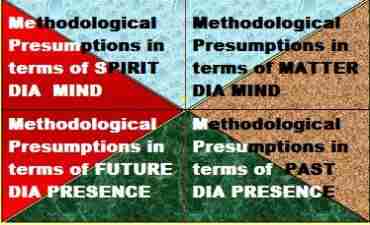
Ultimate or Probable Assumptions of the Dialectical Interactive Approach
DIA
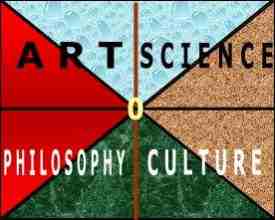
Background Simulation Methodological Settings of the Dialectical Interactive Approach
were used to consider and re-examine this dialectical interactive content under creative consideration, placing them in the four rectangles of this Abstract Creative Framework (for creating knowledge), separated by a cross (+). In this way, the Abstract Methodological Creative Framework has been refined and upgraded into a General Methodical Creative Framework for creating knowledge or for conducting creative discussion, based on these general guidelines and methodological background settings of the dialectical interactive approach. Intentionality is used in this context in terms of the ability of key actors to create the desired reality by applying created knowledge, that is, to implement these hidden, inner intentions of (key) actors of Time in Space (NOW and THERE) into the outer worlds of Space in Time (HERE and NOW), while formulating and defining key concepts (notions) is the next stage in the development of this Methodological Creative Framework of dialectical creatively interactive approach.
- In this broad context of the considered time DIA corresponding space, the mutual conformity of key concepts should be understood in the sense of the (still hidden, internal) conceptual presentation of (key) actors (Time in Space: NOW and THERE) about their desired course of future events in the external dialectical worlds of Space in Time (HERE and NOW: material dia-processes, which should be incorporated or implanted in the past);
- In order for these hidden intentions (and the intentionalities of the key) actors to be implemented in life-, work-, business-, or social reality (abstract ancient element - Earth), it is necessary to have or create appropriate knowledge, as well as to ensure the necessary skills and abilities, including the way to implement all of the above into reality using an appropriate netmode or strategy;
- From this it follows that Time in Space is an active and proactive participant in this interplay within the dialectical Media of time and space, while a far more passive role is assigned to Space in Time on this creative scene, especially taking into account the fact that its firmly established actors would like to maintain and preserve their current positions and established structure within this creative scene, forever if feasible (its ossification);
- However, this is unfeasible, because Time in Space (the hidden and wrapped future in the spirit) is also an active and proactive participant in this interplay within the dialectical understanding of time and space, which in itself does not allow such an undesirable scenario in time DIA suitable situation in space, because the basic feature of this conception of time and space in the dialectical long term is change (dialectics), not movement (dynamics) or status quo (statics);
- Or expressed it using the bipolar way of thinking, even if there were no living beings and life in general (dead, still nature: space), as the case around the planet Earth is, everything is exposed to the erosion of the invisible tooth of time in conjunction with the observable action of four abstract ancient elements: fire, air, earth, water (although the physical manifestation of this abstract liquid element in these earth-encircling expanses of outer space is imperceptible or negligible);
- When looking at the essence of this hidden erosion of the teeth of time, it is not difficult to conclude that this is actually about the destructive effect of change in the dialectical long run. In other words, although dialectical qualitative change is a basic and desirable property and characteristic of dialectics, this is not achievable in the dialectical long run, because various quantitative contents are also embedded in the creative results and outcomes of dialectics. Here, the focus is not on the external visible (harmful) action of the four elements in mutual cooperation, but on this internal, hidden, and invisible action and the erosion of the teeth of time, which is played out and manifested daily in this earthly reality;
- For example, this manifests itself as a gradual decline in the quality of built-in physical contents and ingredients, which inevitably occurs during the passage of time dia space. Or to put it more simply, this manifests itself as the gradual wear and tear of the material used: external matter embedded in the past (Space in Time: HERE and NOW) in cooperation with the inner action of the future hidden and wrapped in spirit (Time in Space: NOW and THERE). If this were not so, then in that case dark matter and energy would not be necessary for the smooth and eternal functioning of the universe. In other words, there would be no need for some additional source of this hidden and invisible matter and this form of manifestation of dialect-spirit in a deeper and broader sense of this term and concept because in that case the existing matter could be reused and recycled endlessly again and again;
- For these reasons, in order to survive on this hot theater stage of Space in Time (as long as possible), everyone is forced, from time to time, to (creatively) actively and proactively operate from these inner worlds of Time in Space;
Note that these seemingly static creative orientation points (landmarks) in these endless worlds of culture, art, philosophy and science can also be triggered and dialectically summarized in terms of common and shared features and attributes of each two adjacent simulation modules (inter-disciplinarity): philosophical-artistic (element - fire: Time in Space), artistic-scientific (element - air: medium of space), philosophical-cultural (element - water: medium of time) and scientific-cultural (element - earth: Space in Time) in this constellation of these simulation modules of dialectical creatively interactive approach. In other words, in this way, this quartet of art, science, philosophy, and culture can also be qualitatively reduced to a triad expressed through their shared properties, unity, and oneness of creative challenge that is creatively considered (element - earth: scientific-cultural dialect). The same is true for the four key notions of the Ultimate or Probable Methodological Assumptions of the Dialectical Interactive Approach.
completion of the dialectical method
Following the basic principles of this ancient approach, the dialectical interactive content under consideration would be divided, summarized, and arranged into four creative dialects according to their common philosophical, cultural, artistic, and scientific features, properties or attributes, by re-classifying and placing this creative content in these four simulation modules. These philosophical, cultural, artistic, and scientific orientation points in the eternity of times DIA infinity of spaces in cooperation with the appropriate constellation of ultimate or probable assumptions of this dialectical method significantly facilitate creative journeys within this methodological creative framework in order to reach the extreme limits of the considered creative challenge of Time in Space (the hidden future in the spirit: NOW and THERE ) ⇄ Space in Time ( matter embedded in the past: HERE and NOW ). Or to put it another way, the boundaries of the known should be expanded by undertaking an appropriate creative traveling BEHIND AND BEYOND the perceived creative challenge that is creatively considered and re-examined in the medium of time (emotively emotional presence dia bodily presence) ⇄ the appropriate spatial medium ( mind dia reason ). In order for the Ultimate or Probable Methodological Assumptions of this dialectical method to function properly, it is necessary to formulate and determine three (3) related key concepts (notions) of dialectical content under creative consideration (1 - element EARTH). This requirement of the dialectical method is accomplished by arranging, grouping, and classifying the dialectical content contained in these four simulative modules in accordance with their common qualities and characteristics. Then, these four interactively creative contents are continually summarized, qualitatively reduced, and harmonized with each other for the purpose of extracting four key conceptual terms that represent and express the essence of the creative challenge of time, in the time DIA space, which is creatively considered, reexamined, and rethought.
As the next step of this methodical procedure of the dialectical interactive approach, the most appropriate abstract symbolic element of this methodical triad consisting of fire, water, and air should be assigned to this dialectical triad of 3 concrete related key-notions (key-concepts), but in such a way to properly match and pair with each other as well as to be in harmony with each other. Depending on how properly in this methodological creative framework, the constituent dialects of these aforementioned methodical triads were arranged, that is, to what extent their common qualities, shared (cultural, artistic, philosophical, and scientific) traits, or characteristics are harmonized with each other, will result in different interpretations of dialectical content under creative consideration (different creative outcomes). In this way, the dialectical content under creative consideration is methodologically formulated in accordance with the requirements of this dialectical method. In other words, this dialectical creatively interactive content of abstract and concrete dialects is ready to be reflected through the prism of this thoroughly explained and elaborated methodological creative framework by using thy capabilities of distinguishing good from bad choices, as well as to avoid inappropriate creative pathways in the purpose of finding the best solution for the identified problem or creative challenge that is creatively considered. As an example of the implementation of this methodological approach in social reality, READ: Love Interpreted in terms of the Unity of its Chosen Dialectical Triad through the prism of the Four Ancient Elements: Fire, Water, Air, Earth.
dialectical method: the triad of thesis, antithesis, synthesis DIA the renewed thesis

Couple Dialect (Matching and Paired Dialects): Thesis DIA Antithesis

Synthesis (Six-Pointed Star) DIA "G" - Hexagon → The Renewed Thesis in Time DIA Space
In other words, by placing these four real (concrete) dialectical contents in this abstract methodological creative framework, the dialectical tensions among and between these four elements (fire, water, air, earth) are additionally strained, very prone to interactively creative change of their existing forms into some another kind of their mutual manifestation. For this purpose, the previously elaborated and explained methodical procedure of the elementary school of dialectic was used for the mutual interaction of the paired dialects of thesis and antithesis (couple dialect). In other words, the creative synthesizing of the contained quality of this paired dialect of thesis and antithesis, understood in terms of their reunion into a dialectical synthesis (the triad of thesis, antithesis, and synthesis: six-pointed star), results in a renewed thesis (hexagon - "G"), which expresses the unity and oneness of this creatively considered triad at a new (preferably qualitatively higher) level of time DIA the appropriate space (spirit, mind dia reason, matter) and so on until a temporary conclusion of the considered creative challenge is reached [temporary final hexagon of the last pictorially shown six-pointed star]. In short, all the previously considered abstract and concrete paired dialects of this dialectical method can be creatively expressed in this pictorially vivid way of the implemented primary six-pointed school of dialectic.
It is very important to emphasize here that during the process of knowledge creation, and especially, during the development of a general model of artificial intelligence that is based on this dialectical methodological creative framework, the biggest creative challenge during reaching the temporary conclusion of the started dia-processes is to determine the number of iterations in this type of manifestation of the do-while loop (the number of depicted hexagons inside this initial six-pointed star). In other words, the number of executed and dialectically condensed triads of thesis, antithesis, synthesis into a renewed thesis (1 - their unity and oneness) DIA the complemented antithesis ...... depends on the final quality of the initiated dia-processes, which is to be achieved. Or to put it in another way, since each achieved quality of initiated dia-processes is limited with the allocated time interval DIA the appropriate space, its final qualitative creative outcome cannot be waited for forever, understood also in terms of endless spending of allocated resources of space (spirit, mind dia reason, matter). One way to solve this creative challenge is to gradually increase the number of iterations during the qualitative review of the thesis, antithesis, synthesis triad DIA the renewed thesis in the previously mentioned do-while loop in accordance with the (higher) level of quality that is to be achieved within the space used DIA the appropriate time interval.
In addition, the dialectical merging and further summarizing of these two temporarily condensed six-pointed stars of the above creatively considered concrete and abstract dialects also results in a twelve-pointed star (the second basic dialectical principle). Dialectical content which has already been presented and interpreted during the attendance of this "primary and higher school of dialectic" reveals (all) the complexity of dialectical summarization and synthesis of several dialectically initiated processes in time DIA space into a renewed dialectically creative interactive content. And it is here that the conception of Dialectics of Dialectics DIA Negation of Negations comes to the fore. In addition, these dialectically initiated methodological settings of simulation modules in cooperation with far more abstract Ultimate or Probable Methodological Assumptions manifested in the form of three basic dialectical principles, aspects, properties, and manifestations of time DIA space, especially in cooperation with the second basic dialectical principle, determine the probable end result of the initiated dia-processes (rhombus or twelve-pointed star) using innate reasoning abilities (common sense), that is, just as an ungerminated seed will not grow into a plant, so an unbloomed plant will not bear fruit.
secrets of the ancient four elements: final thoughts
The revealed secrets of this pre-ancient knowledge and the methodological approach used, that is, the secrets of these four pre-ancient elements have almost nothing in common with the interpretation by those by those who were unfamiliar with this hidden knowledge. Such texts and books, based on rumors "heard-said" related to this hidden higher knowledge, have been written and published since ancient times, and whose contents can be read in libraries around the world, as well as on the Internet, although the essence and real meaning of these four elements that form the methodological basis of pre-ancient knowledge were perpetuated by the construction of the pyramid of Cheops in Egypt. The exception, in my opinion, is only the great Greek philosopher Plato. In short, the riddle of the four pre-ancient elements was solved by revealing their true (symbolically figurative and creative) meaning and purpose within this hidden higher knowledge, and then these secrets were embedded in this revived methodological approach: DIALECTICAL INTERACTIVE APPROACH. In other words, their bright side understood in terms of their innate ability to create and renew each other was used for creative purposes by incorporating the symbolic meaning of this fruitful role of theirs into this methodological framework for creating new knowledge or for renewing and perfecting existing knowledge. For additional information, READ: Dialectical Interactive Approach: Its Methodological Creative Framework.

The Background Simulative Methodological Assumptions of the Dialectical Interactive Approach
I hope that these creative articles will shed more light on this enigmatic and still insufficiently understood dialectical content of the process of creation and emergence of knowledge because a much broader framework for creative orientation has been reintroduced in this dialectically created eternity of times DIA infinity of spaces within the considered worlds of dialectic. A potentially very useful ROLE of philosophy, science, art, and culture should also be added here, understood in terms of their interactive application for creative purposes, instead of a narrowly specialized understanding of their role during the process of knowledge creation in the sense of EITHER science OR philosophy OR art OR culture. Since these interactively creative dialectical processes also take place within the established societal universe of dialectically redefined time DIA space, all the resulting social aspects and manifestations of Time in Space DIA Space in Time were also reflected, reconsidered, and rethought through the methodological prism of these FOUR ELEMENTS (fire, water, air, earth), whose secrets were embodied in the DIA inspired the construction of all the ancient pyramids.
READ the Next Part: A SUMMARY OF THE DIALECTICAL INTERACTIVE APPROACH, SEEN FROM THE VIEWPOINT OF DIALECTICAL UNDERSTANDING OF TIME DIA SPACE
Go to the Table of Contents
© Copyrights 1996-2018, All Rights Reserved ®












